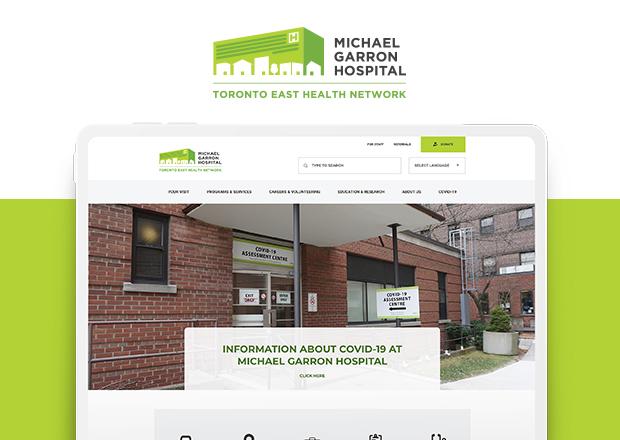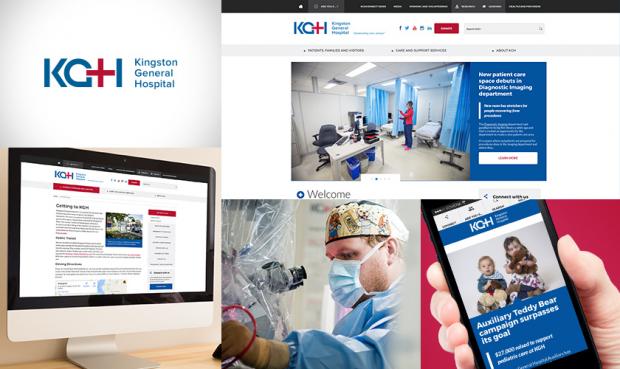 Support for Drupal 7 is ending on 5 January 2025—it’s time to migrate to Drupal 10! Learn about the many benefits of Drupal 10 and find migration tools in our resource center.
Support for Drupal 7 is ending on 5 January 2025—it’s time to migrate to Drupal 10! Learn about the many benefits of Drupal 10 and find migration tools in our resource center.Photo credit: Matthew Manor/KGH
Already a regional leader in healthcare with an internal priority on patient-focused care, Kingston General Hospital (KGH) was ready to bring the patient-centric experience it was known for in real life, to the web. Much was at stake: it was essential that the hospital provide a dynamic, real‐time communication experience across several online properties.
KGH achieved their goals following a complex, multi-year, multi-phase project that would ultimately involve the roll-out of a new technology platform - Drupal - to the organization, reprioritize web communication as a capital asset, and see the complete retooling of two public facing sites, three microsites, and the launch of a revolutionary social intranet.
Their investment in Drupal generated savings for the organization and made communication more effective, enabling participatory, two‐way communication with staff, ensuring rapid, steady flow of credible, timely information and empowering people with real information and understanding.

After reviewing the scope of KGH’s project and the organizational goals, Northern recommended the Drupal content management framework. Why? Due to the number of online properties involved, the budget, and the hospital’s overall goal to align various branding elements across new microsites, Northern felt Drupal was the right fit and would be readily adopted by KGH’s competent in-house technical team. It is easily customizable, scalable, capable of integrating with third-party systems and data feeds, and is user-friendly.
KGH liked the fact that Drupal is a well structured, mature and highly flexible and extensible development framework that allows enterprise level feature sets while offering zero-cost licensing. This allows to maximize budgetary expenditures as the entire budget is utilized on the solution, vs. the high cost of licensing for proprietary solutions.
Kingston Health Sciences Centre is southeastern Ontario Canada’s largest acute-care academic hospital. Through the facility in Kingston, and 24 satellites through southeastern Ontario, it serves the almost 500,000 residents who live in a 20,000-square-kilometre predominantly rural area, as well as some communities on James Bay in Ontario's north.
KGH maintained two external corporate websites, built on two different development platforms that had to be updated separately, and by different hospital departments. The main corporate website, built in Microsoft Sharepoint, was difficult and time‐intensive to update. The other, on an older version of Drupal, was the KGH Connect social media/news site. That site was updated almost daily, and was well integrated with social media, including Facebook, Twitter, YouTube and blogs.
The existing intranet was built on MedWorks. It was non-responsive, cumbersome to update, hard to navigate and rarely used by its intended target market. Of those that did use it, a significant percentage did not have access to a dedicated computer with web capability.
Goals
- One public website that integrates the functionality of the existing KGH public website and the KGH Connect social media/news site
- A new site for the Southeast Regional Cancer Program, to be built on the same platform as the KGH public website
- Provide an overarching structure that can house individual microsites for patient care programs, the research institute, and a learning program
- Launch a new social, collaborative productivity platform for KGH staff, physicians, learners and volunteers (intranet)
Approach
Phase one of the renewal would include the development of all public-facing websites.
Phase two of the renewal would include redevelopment of KGH’s intranet.
Requirements
- Accessible and W3C compliant
- Ability to house French-translated copies of web pages
- Flexible design that allows for multiple content configurations and the callout of feature information
- Built-in style sheets to support consistent look and feel of layout and content throughout the site
- Mobile friendly
- Centralized and distributed content management, with the ability to assign editorial and publication rights
- Ability to create/populate program webpages within a microsite framework
- Ability to house information in a single location on a back-end system, but post in more than one place
- Ability to share information between the public website and intranet
- Ability to view external web content within KGH/SERCP webpages
- Ability to tag information for the purposes of content management, organization and searches
- Full integration with business and clinical tools
- Full integration with social media
- Ability to produce and collect information from online forms
- Ability to post career opportunities and accept online applications
- Ability to size text
- Ability to resize photos from within CMS
- Searchable calendar of events
- Ability to conduct global searches and search people, services, files, etc.
- Ability for dynamic updates with an archiving system
- Ability to post wait time information for specific clinical areas
- Ability to post video
- Ability to host virtual tours of facilities
- Ability to run online polls
- Cross-platform browser compatibility
Requirements uniquely specific to KGH's new intranet
Instant messaging, calendar sharing, document sharing, project management, collaboration and workflow, ability to personalize home page, social profiles of KGH staff, physicians, learners and volunteers.
Outcome
Two public facing sites and microsites were launched, in addition to a new intranet.
KGH public website
The new public facing website provides the overarching structure that houses individual microsites for patient care programs, the research institute, and the learning program. Visitors to the site have the option to identify as either a patient, family member or visitor; a job seeker, volunteer or learner and target information specific to their needs. Many parts of the website have also been crafted to help prepare patients for what to expect during their journey to, through and from KGH. For example, the Diagnostic Imaging Care section walks people through the different types of imaging procedures and includes information to help them get ready for their appointment. The new website was designed to work seamlessly on mobile technologies, including all mobiles and tablets, integrates with social media and is also fully accessible.
http://www.kgh.on.ca/
South East Regional Cancer Program website
This is a new site, and exists independently of the KGH public website. It is however, built on the same platform as the KGH public website, and serves as a regional portal to all cancer services and providers in southeastern Ontario and is a seamless view of the cancer care continuum.
http://cancercaresoutheast.ca/
The KGH intranet
Called KGH Today, this social, collaborative productivity platform for staff, physicians, learners and volunteers was built using Northern’s Drupal based intranet product, EchidNET. It is a fully-responsive, multi-site, multi-role solution featuring department based collaboration tools, light-weight document management, detailed content creation and approval workflows, and Active Directory integration allowing seamless Intranet access internally and externally from both desktop and handheld devices. It is fully AODA compliant, with advanced full-text search capabilities via a SOLR search appliance. It offers revision history with roll-back on all content, and feature personalization for content, calendars and much more.
Microsites
The KGH Research Institute microsite offers extensive resources for researchers and their teams, and provides information for patients and families interested in taking part in hospital-based research.
http://www.kgh.on.ca/research
Learning at KGH microsite relays KGH's inter professional education efforts.
http://www.kgh.on.ca/learning
Summary
In summary, the hospital’s online websites are no longer disconnected, immobile and difficult to access. Whereas previously, websites had been developed in isolation and in reaction to specific corporate demands, without the context of an overarching strategy for web communication, now there is a clear path and direction for growth.
Technical specifications
Apache Solr Multilingual provides an out-of-the-box solution to language-specific problems - in this case English and French translation - and supports the site administrator by providing a user interface that hides some of the complexity.
Block languages enables language selector for blocks and optional block translation
Subsite lets you make any node or set of nodes look like a different website by overriding the theme, branding, main menu, and more. Subsite has been designed to be used by editors as part of the editorial process. Configuration for each subsite is stored with the node in a field which means it supports content revisions and works with your usual content workflow.
With the Paragraphs module, content editors have control over the flow of content. Paragraph types build a robust, beautiful, responsive basic page in minutes.
Pathologic is an input filter which can correct paths in links and images in Drupal content in situations which would otherwise cause them to “break;” for example, if the URL of the site changes, or the content was moved to a different server.
